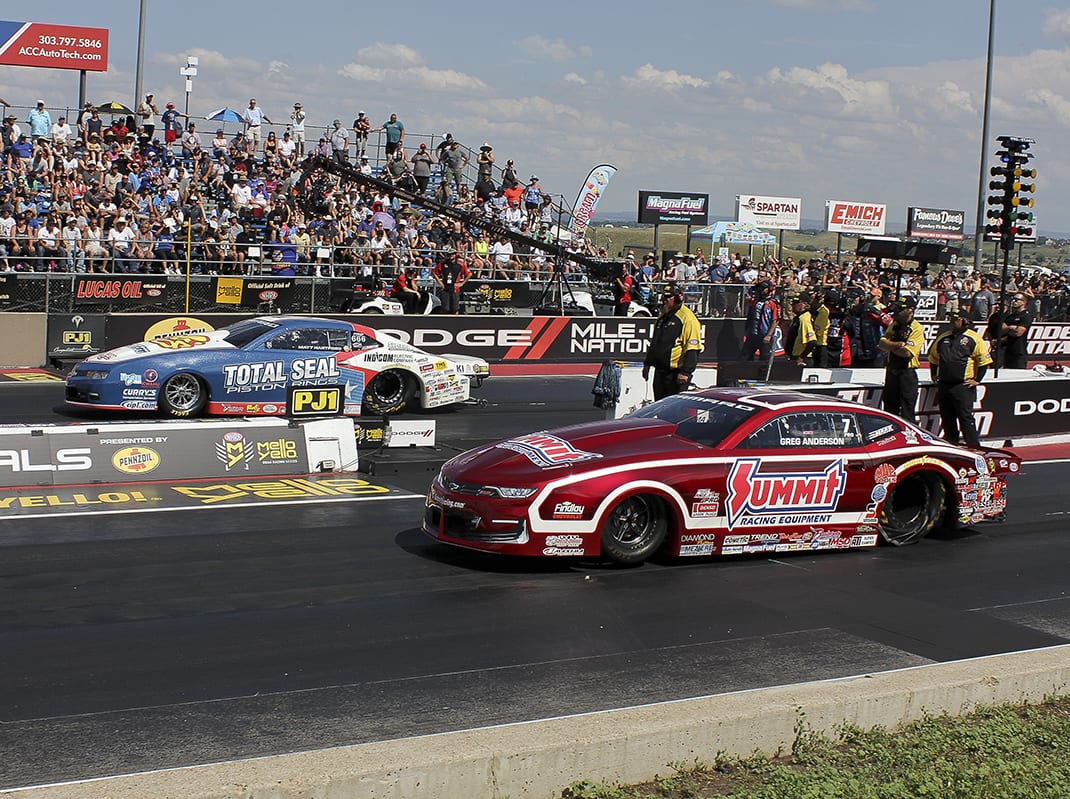Factory Stock Showdown is another class whose status has skyrocketed. Versatile Bo Butner, the 2017 Pro Stock champion, won the inaugural 2012 Factory Stock Showdown, a race-within-a-race at the U.S. Nationals that showcased America’s Big Three automakers with the Ford Mustang Cobra Jet, Dodge Challenger Drag Pak and Chevrolet COPO Camaro.
Since then it has become a class and series of its own. It steadily increased from three to four to five races, then to seven last year when Top Fuel driver Leah Pritchett claimed the championship. This year’s schedule has eight events — and plenty of talented drivers, many from the Mello Yello Series ranks.
Class veteran David Barton, pointing to a rediscovered muscle-car craze, described it as “everything I love about drag racing … heads-up, everything-you’ve-got, full-throttle racing — and it’s what people want to see.”
The Top Fuel Harley class, with its nitromethane-powered bikes that are capable of zipping 220 mph, joined the Mello Yello Drag Racing Series in 2017 with eight races and has expanded to 10.
Generating the biggest buzz this season has been the pared-back Pro Stock schedule, from 24 races to 18. A skeptical initial reaction to the move seems to have given way to positive feedback from most team owners and drivers.
Richard Freeman, whose Elite Performance accounts for nearly half of the field, said the short schedule is “awesome, absolutely. It’s cheaper, and it gives us more time at home. It’s just better, better for everybody. We’ve done our Pro Mod program and we couldn’t do that without having shorter time. So it works well. I was a proponent for it for a long time.”

For next year, Freeman is anticipating the “same thing, just different races, I believe. They’re going to take us to places we weren’t this year and just keep rotating it. I believe it’s good.”
Chris McGaha, who said that with a 24-race agenda he wastes 48 days a year in airports, is content with the new calendar.
“I think 18 is about the right number,” he said. “We can work a little bit on the schedule and what the 18 are. It’s a long, long break (early in the year), then there’s like seven races in nine weeks toward the middle. But 18 seems to be about the right number.”
An unpleasant side effect was drivers Alan Prusiensky and John Gaydosh losing sponsorship. Both are East Coast racers, and four of the six races the NHRA took away were races their sponsors wanted a presence.
Gaydosh left the sport and, fortunately, Prusiensky found another primary sponsor.
Four-time Pro Stock champion Greg Anderson framed his opinion about the line-up of events by the Countdown to the Championship.
“It’s a different year with only 12 races in the regular season before the Countdown,” he said. “So you don’t have a cushion like you’ve had in years past. You can’t really use any race as a test session to prepare for the Countdown. There are too may quality cars, so you’re going to have to race every race, or you’ll find yourself on the outside. If you have two or three bad races, you won’t even make the Countdown.
“I’ve always said that I love to race as much as possible, but I also love my time at the shop,” Anderson noted. “We have more time to work on things there. Generally, during the regular season you don’t have much time to do research and development. But this year, we’re (having) more time for that. This could be a set-up year for the future.”
Back in the class on a regular basis because of the shorter schedule are Bo Butner (who had announced he was leaving for other classes), Rodger Brogdon (who had taken a hiatus), Wally Stroupe and Fernando Cuadra, as well as two of his sons.
“We’ve received positive feedback from the Pro Stock racers. The truncated schedule provides them more time to work on their cars and has improved the health of the class. We are seeing full car counts in Pro Stock, so we do think it’s working,” Hatcher said. “It’s also creating demand. We do hear from a lot of fans who want to see Pro Stock in their markets, hence the concept of rotating the schedule a bit.”
Reduced costsand more time are the main reasons the change is working.
“It’s a little bit of both,” Hatcher said. “Some Pro Stock competitors who could not run a full 24-event schedule are coming back out to race this year, even if they can’t make it to all of the races. They feel they have more of a shot at doing well in the points now that the schedule is lighter. All the teams are taking advantage of the extra time they have to fine-tune their machines. Pro Stock is such an intricate and analytical category. Teams are looking for every bit of power they can find, which means taking the time to test and examine data. So that’s been beneficial.
“From what we’ve seen so far,” she added, “Pro Stock teams like the benefits they are experiencing from running an 18-event schedule. But I’m sure they miss seeing the fans when they are off the road for a while.”
Freeman understands.
“On that side of the table it’s just different,” he said. “They’re in business to make money and they’re struggling. So what they do is they cut expenses. My saying is you can’t save yourself into a profit. They’re going to have to do something. And we’ll see what they do.”
